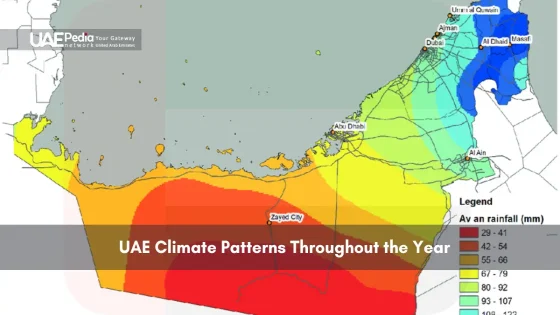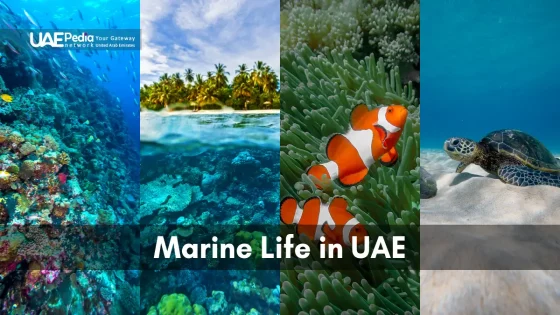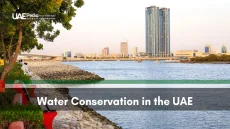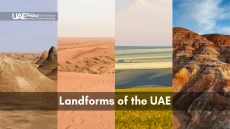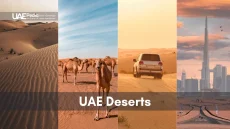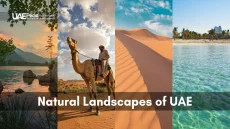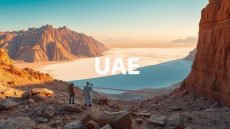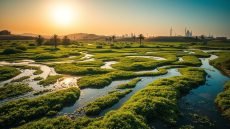Did you know the desert sun here can push thermometers to 122°F (50°C) – matching Death Valley’s notorious heat? This land of extremes reveals weather stories far beyond its glossy skylines.
Living here means swapping snow boots for sandals by November. Winter mornings might dip to 57°F (14°C) near Al Ain’s mountains, while summer turns coastal cities into open-air saunas. Rainfall? Scarce but dramatic – Dubai averages just 3.7 inches yearly, often arriving in sudden February downpours.
We’ve tracked patterns using decade-old records from the Dubai Meteorological Office. August’s average high hits 106°F (41°C), yet January nights occasionally chill to 50°F (10°C). These swings aren’t quirks – they’re signatures of a tropical desert climate that shapes daily life.
Our journey through seasonal shifts and regional contrasts starts here. You’ll discover:
- Why coastal humidity feels hotter than desert dryness
- How ancient trade winds still influence modern forecasts
- Where to find surprising microclimates beyond the dunes
Pack your curiosity – we’re decoding this sunbaked puzzle together.
Exploring Seasonal Variations in the UAE
Imagine swapping snow shovels for beach towels between December and March. The cooler months (November-February) transform this sun-drenched land into a playground of 72°F (22°C) days and crisp 54°F (12°C) nights. But step into central Dubai after sunset, and you’ll feel concrete radiating warmth like a giant radiator – a textbook urban heat island effect.
Winter’s Gentle Contrasts
Outskirts near Hatta Mountain reveal nature’s thermostat at work. Rural areas cool 5-7°F faster than city centers at night. Winter also brings 90% of the region’s annual precipitation, though “rainy season” here means maybe six drizzly days. Locals joke: “Our umbrellas collect more dust than water!”
Summer’s Fiery Breath
June-August turns the mercury ruthless. Coastal humidity pairs with 122°F (50°C) peaks to create heat indices rivaling steam rooms. Saudi’s shamal winds occasionally paint skies orange with dust storms – nature’s reminder of desert dominion. Urban planners counter with shaded walkways and heat-reflective paint.
| Season | Day Temp | Night Temp | Key Features |
|---|---|---|---|
| Winter | 72°F (22°C) | 54°F (12°C) | Outdoor festivals, desert camping |
| Summer | 106°F (41°C) | 86°F (30°C) | Indoor malls, midnight beach swims |
“We don’t fear summer heat – we dance with it. Markets open at dawn, families gather post-sunset, and skyscrapers wear sunglasses.”
These extremes shape everything from building codes to school schedules. Newcomers quickly learn: seasons here aren’t just weather patterns – they’re cultural choreographers.
Data-Driven Insights on Weather Trends
Numbers don’t lie – especially when they’re sweating through summer at 122°F. Let’s crunch the digits behind your sunscreen routine and beach plans.
Temperature Records and Precipitation Patterns
Dubai’s weather archives reveal a plot twist: January’s average low climbed 3°F since 2000. July’s peak? It’s broken records 5 times this decade. Check this snapshot from national monitors:
| Month | Avg High | Avg Low | Rainfall |
|---|---|---|---|
| January | 75°F (24°C) | 57°F (14°C) | 0.4″ (10mm) |
| April | 95°F (35°C) | 73°F (23°C) | 0.2″ (5mm) |
| August | 106°F (41°C) | 86°F (30°C) | 0.0″ (0mm) |
That stubborn zero in August’s rainfall column? It’s why distinct climate zones matter. Mountain towns like Jebel Jais get triple Dubai’s drizzle – nature’s sneaky way of diversifying ecosystems.
Sea Temperature and Ultraviolet Index Observations
Persian Gulf waters aren’t just bath-warm – they’re climate change thermometers. Summer surface temps hit 95°F (35°C) last August, bleaching corals but delighting snorkelers. NOAA’s UV index readings? They regularly hit 11+ (“extreme”) from May-September.
Local meteorologists advise: “Treat midday sun like a laser show – admire from shade.” Morning beach walks and sunset dhow cruises become survival strategies when UV radiation peaks. The data’s clear: our relationship with the sun keeps evolving, one SPF layer at a time.
Impact of Climate Change on the United Arab Emirates
Skyscrapers shimmer like mirages while desert sands whisper warnings – this land of black gold now faces its toughest paradox. Rising temperatures and erratic rainfall test infrastructure built for eternal sunshine. Coastal highways flood during freak storms, while heatwaves force oil rigs to pause operations. Urban hospitals report more heatstroke cases, yet rural communities battle dwindling groundwater.
When Progress Meets Pressure
Abu Dhabi’s Masdar City shows how innovation fights back. Solar-powered districts cool streets naturally, while AI-managed farms grow crops with 90% less water. The capital’s Energy Strategy 2050 aims to triple renewable output – crucial for a nation where crude production still funds 30% of GDP.
Last year’s record rainfall (4 inches in 24 hours) exposed drainage gaps in aging neighborhoods. Now, new buildings feature elevated foundations and rainwater capture systems. As one engineer told us: “We’re retrofitting cities like vintage cars – keeping the charm but upgrading the engine.”
Green Blueprints in Action
Three game-changers emerged from recent economic diversification strategies:
- Carbon-neutral steel plants recycling industrial emissions
- Mangrove restoration projects buffering coastlines
- Smart grids reducing energy waste in office towers
Abu Dhabi’s oil titans now invest heavily in geothermal tech. Even traditional souks install misting fans – blending heritage with heat resilience. For residents? Think shaded bus stops, 24/7 cooling centers, and work-hour shifts avoiding midday sun.
“Climate change isn’t a future threat here – it’s today’s renovation permit. Every policy update, every solar panel, they’re survival tools dressed as progress.”
Regional Differences and Microclimates
Picture this: you’re sipping iced karak tea on a breezy Dubai marina one moment, then choking on desert dust 90 minutes inland the next. The arab emirates packs more environmental variety into its borders than most realize – if you know where to look.
Coastal Environments vs. Desert Landscapes
Persian Gulf breezes give coastal areas their signature sticky summers – think 90% humidity hugging Dubai’s skyscrapers. But venture inland toward Al Quaa, and you’ll swap mugginess for mercury madness: 122°F days followed by 60°F nights. “It’s like nature forgot to install a thermostat,” laughs a Bedouin guide we met near Liwa Oasis.
These contrasts stem from the nation’s diverse landforms. Coastal zones battle salt spray but enjoy milder winters, while desert interiors face sandstorms that reshape dunes overnight. Check how Abu Dhabi’s Corniche compares to Al Ain’s rocky plains:
| Location | Summer High | Winter Low | Unique Challenge |
|---|---|---|---|
| Dubai Marina | 104°F (40°C) | 64°F (18°C) | Salt corrosion |
| Empty Quarter | 122°F (50°C) | 54°F (12°C) | Dust devils |
Urban planners play chess with these microclimates. Palm Jumeirah’s crescent shape deflects waves, while desert suburbs use native plants as natural sand barriers. As one architect told us: “We design buildings that breathe differently in each region – like tailored suits for the weather.”
“My morning commute crosses three climate zones – AC blasting in the car, scarf wrapped at the metro station, sunglasses on by the office. Welcome to the united arab experience!”
From fog-catching nets in mountain towns to humidity-controlled malls, these variations shape daily life across the middle east’s most dynamic landscapes. Next time you feel a sea breeze or spot a dust cloud, remember: you’re witnessing geography’s live remix.
UAE Climate: Patterns, Data, and Future Outlook
Weather archives reveal a plot twist – the nation’s heat curve now climbs faster than Burj Khalifa’s elevators. Since 2000, summer nights warmed 4°F while winter rainfall became 23% more erratic. Last July shattered records with 129°F (54°C) in Sweihan, hotter than Death Valley’s average.
Historical Climate Data and Recent Extremes
Meteorologists track curious patterns: February 2024 delivered 3 years’ worth of rain in 48 hours. Meanwhile, Persian Gulf waters simmer at 96°F – perfect for coral refugees relocating to artificial reefs. Check these eye-openers from national reports:
- Heatwaves now start 18 days earlier than 1990s averages
- Dust storms increased 27% since 2015
- UV radiation spikes to “extreme” levels 158 days/year
“Our ancestors navigated by stars,” says a veteran forecaster. “Now we navigate between weather models and emergency protocols.”
Innovative Measures and Policy Actions
The UAE National Cloud Seeding Program conducts 250+ missions yearly – modern rain dances with science. COP28 initiatives birthed the world’s largest solar park, while mangroves expand by 150% since 2020. Three game-changers reshaping the landscape:
- AI-powered weather stations predicting sandstorms 6 hours earlier
- Seawater-cooled districts in Masdar City
- Tax breaks for buildings using heat-reflective materials
“We’re not just adapting – we’re rewriting desert survival rules. Every raindrop and sunbeam gets a second job.”
From ancient falaj irrigation to robotic pollinator drones, the nation turns challenges into blueprints. As data meets determination, even the harshest forecasts spark innovation.
Reflections and Future Perspectives on UAE Weather
As dusk settles over Abu Dhabi’s mangrove parks, solar-powered lights flicker on – symbols of a nation rewriting its relationship with nature. The united arab emirates stands at a crossroads, blending ancestral desert wisdom with AI-driven weather models. Record-breaking heatwaves and recent extreme rainfall events reveal both vulnerability and ingenuity.
Three lessons emerge from decades of data: coastal cities need smarter flood defenses, desert communities require sustainable cooling solutions, and everyone benefits from real-time dust storm alerts. Abu Dhabi’s mangrove expansion and Dubai’s heat-reflective roads show progress, but oil revenues still fuel 40% of green initiatives – a delicate dance between legacy industries and future needs.
What’s next? Imagine farms using evaporated seawater for irrigation, or skyscrapers doubling as vertical wind tunnels. The arab emirates could pioneer desert-specific climate tech – if investments match ambitions. Nighttime temperatures now drop slower than in the 1990s, while winter rains arrive in unpredictable bursts.
Here’s the hopeful twist: every challenge sparks innovation. Bedouin-inspired architecture cools modern homes, and ancient falaj water systems inspire smart grids. Want to join the conversation? Track how shifting precipitation patterns affect date palm harvests, or why desert fireflies now appear in new areas.
Our final thought: this land’s story isn’t written in sand, but in the determined steps between shifting dunes. What weather wonders will tomorrow reveal? Pack your curiosity – the forecast’s always changing.
Think sunny days (68-77°F) with cool nights—perfect for desert camping or coastal walks. Rain rarely crashes the party, but when it does, wadis briefly flow and cities slow. Urban areas like Dubai trap heat, so pack layers for that concrete-and-glass warmth.
Adaptation’s an art here! Malls become midday oases, while traditional majlis gatherings shift to evenings. Hydration stations pop up nationwide, and lightweight breathable fabrics rule outfits. Pro tip: Check UV indexes—hats and SPF 50+ are non-negotiable.
Rising sea levels nibble at coasts, while hotter summers strain energy grids. Dust storms now arrive earlier, and rare rainfall patterns shift unpredictably. But innovations like Abu Dhabi’s Masdar City test solar-powered solutions to balance growth with sustainability.
Coastal humidity hugs Abu Dhabi’s corniche, while Dubai’s urban sprawl traps heat. Head inland to Al Ain, and mountain breezes cut through desert dryness. Microclimates mean packing flip-flops for beaches and closed shoes for dunes—all in one road trip!
From Sharjah’s mangrove nurseries to Dubai’s solar-powered metro, the Emirates invests heavily. The UAE Net Zero 2050 strategy pushes renewable energy, while “cloud seeding” tech aims to boost rainfall. Even fossil fuel profits now fund wind farms and carbon capture labs.
